The photovoltaic power plant financial model used by most photovoltaic power plant investors in China is, conventionally, reduced by approximately 5% in three years over the three years, and reduced to 80% after 20 years for accounting purposes. Photovoltaic power plants are relatively large initial investment projects, like the insurance, financial management and other industries, is an industry that requires actuarial, recent report issued by the certificate center shows: "through the test of 425 power stations, found that photovoltaic components are mainly heat For quality problems such as spotting, cracking, and power attenuation, such as power attenuation, in the one year or so of the 11 large-scale terrestrial power stations that we tested last year, after considering the uncertainty of the equipment, we found that 51% of the components were attenuated. Between 5% and 10%, about 30% of the module's power is attenuated by more than 10%, and 8% of the attenuation is more than 20%.†Qin Haiyan, Director of Beijing Jian Heng Certification Center, said, “We had sampled a 10MW project in Gansu. 219 sampling inspection components, 127 components significantly reduced power consumption, accounting for 58% of the sampling rate. "This means that manufacturers generally promised 25 years of attenuation of the 20% warranty in the first year of operation to attenuate severely or have reached the bottom line of commitment.
The correct selection of PV modules will become more and more important for the power generation and stability of the power plant. In the past few years, domestic investment PV power plants have pursued the lowest initial investment. After several years of power plant construction and the power station investors have a rational understanding of the power station core values. As a result, the consensus reached by the industry per capita is that the cost of electricity has become a key indicator for measuring the value of power plants and trading premiums.
As Zhong Baoshen, chairman of Xi'an Longji Silicon Materials Co., Ltd. stated, “The core evaluation criteria for the value of PV power plants lies in the cost of power generation. The core of reducing power generation costs depends on three aspects: first, reducing the cost of the unit system; secondly, improving the operation of the system. Life cycle; Third, increase the amount of electricity generated per watt. "Overview of these three aspects, it is the cost of electricity for photovoltaic power plants.
Before our system's analysis of PV power plant component selection, we first performed a systematic analysis of the cost of electricity.
· Definition of electricity cost:
The electricity cost of photovoltaic power generation refers to the comprehensive cost incurred by the grid electricity of the photovoltaic project, which mainly includes the investment cost, operation and maintenance costs and financial costs of the photovoltaic project.
1 Investment cost:
The costs resulting from the capital investment during the development and construction of photovoltaic projects mainly include: equipment purchase costs, construction project costs, installation project costs, pre-development fees, land acquisition fees and other fees and project construction period interest. During the operation period of the project, it is reflected in the form of depreciation of fixed assets.
2 Operation and maintenance costs:
It is the maintenance cost incurred during the project's operational life to ensure the normal operation of the equipment. It mainly includes: maintenance costs, spare parts purchase costs, insurance premiums, and management fees, which are closely related to the equipment performance.
3 Financial expenses:
It is the interest cost formed by the long-term loans incurred during project construction and the liquidity loans incurred during the project operation period. It mainly includes long-term and short-term loan interest, which is closely related to the loan repayment period and interest rate of the project.
· Calculation of electricity cost
At present, there are mainly two methods for cost analysis of photovoltaic power generation: static cost method and dynamic cost method.
· Static cost method:
C=[(O+M)+T+S]/N
among them:
C: electricity cost (yuan/kwh); N: annual average electricity generation (kwh); M: annual average maintenance fee (yuan); O: annual average operating cost: including material costs, management fees, and wages and benefits ( Yuan); T: annual average depreciation expense (yuan); S: annual average financial expense (yuan)
· Dynamic cost method:
C=[I*CRF+(O+M)]/N

among them:
I: Initial total investment of the project (yuan); n: Lifespan of the project (year); i: Discount rate (loan interest rate); CRF: Equal capital recovery factor; (O+M): Average annual operation and maintenance cost
The dynamic costing method, also known as "lifetime cost," is to evenly distribute all costs incurred in the PV generation process over the life of the project over the life of the project.
· case analysis:
Take the current 10MW ground-based photovoltaic power generation project in the western part of Wuwei, which was connected in the second half of 2012 as an example:
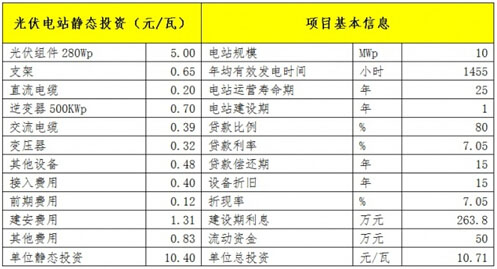
Through calculations, during the 25-year operation period of the photovoltaic power plant, the average annual power generation capacity is 1,455 (million kWh);
Static electricity cost of the project: C=[(O+M)+T+S]/N Calculate the electricity cost of each year:
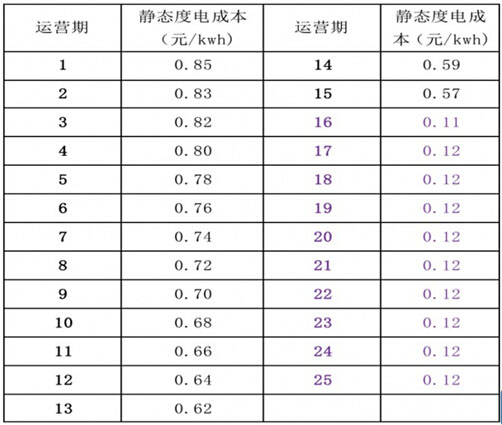
From the above calculations, it can be seen that in the repayment period (1-15 years), the cost of photovoltaic power stations is relatively high, reaching a maximum of 0.85 yuan/kwh and a minimum of 0.57 yuan/kwh; after the repayment and depreciation are completed, The cost of electricity will be reduced to 0.12 yuan/kwh. From the calculation of static costs, it can be seen that during the repayment period, the cost of photovoltaic power generation is very high, but this is not the case during the lifetime of the entire project. Therefore, by calculating the dynamic costs, all expenses incurred in the photovoltaic power generation process will be evenly distributed during the life cycle, which is conducive to a more comprehensive understanding of the cost of photovoltaic power generation during the entire operation period.
The above sensitivity analysis shows:
(1) When the cell conversion efficiency is unchanged (18%), when the module price drops from the current 5 yuan/w to 3.78 yuan/w, the cost of electricity will decrease from the current 0.74 yuan/kwh to 0.67 yuan /kwh.
(2) In the case of a component price of 5 yuan/w, when the battery conversion efficiency increases from 18% to 20%, the cost of electricity will be reduced from the current 0.74 yuan/kwh to 0.67 yuan/kwh.
(3) In the case of a module price of 4.7 yuan/w, when the battery conversion efficiency increases from 18% to 20%, the cost of electricity will be reduced from the current 0.72 yuan/kwh to 0.65 yuan/kwh.
(4) In the case of a component price of 3.78 yuan/w, when the battery conversion efficiency increases from 18% to 20%, the cost of electricity will be reduced from the current 0.67 yuan/kwh to 0.60 yuan/kwh.
Thus, the project's investment costs and power generation efficiency are important factors affecting the cost of electricity. In order to further reduce the cost of electricity generated by photovoltaic power generation, it is necessary to simultaneously increase the conversion efficiency and attenuation of the battery while reducing the cost of components and other equipment. Stability, the two can not be neglected.
Based on this analysis, the author believes that the use of single-crystal modules to implement photovoltaic power plant construction will be the most effective way to achieve the lowest cost of the power plant.
At present, there are two types of crystalline silicon cells and thin-film batteries on the global solar power station market. The photoelectric conversion efficiency of thin-film battery products is still increasing, combined with the lack of scale, and the cost reduction is slow. Crystalline silicon batteries account for nearly 90% of the market, thin-film batteries account for about 10%, and the largest supplier of thin-film modules is First-solar of the United States.
In the field of crystalline silicon cells, there are differences between polycrystalline silicon cells and monocrystalline silicon cells. In the PV market in 2013, the demand for solar cells totaled 34.7 GW, of which polysilicon supplied 21.9 GW, which is the mainstream of photovoltaic cells, and the proportion of monocrystalline silicon cells is not high. Unverified data shows that in the domestic photovoltaic market, monocrystalline silicon is currently only a few percent of the share, and the rest are mainly polysilicon batteries. The difference in market share of monocrystalline silicon and polysilicon is mainly due to the low threshold of polysilicon products and the easier expansion of production when photovoltaic products are scarce, resulting in the current monocrystalline silicon production scale is not comparable to polysilicon, domestic early battery companies and silicon material companies. Most of them are polysilicon routes, so they take the lead in the domestic market.
Affected by the rapid start of China's photovoltaic market, single crystal silicon, which accounts for a relatively small percentage in the Chinese market, has lowered the proportion of the global market. From a global perspective, the proportion of monocrystalline silicon cells is gradually increasing. A research report by BOCI International showed that the market share of single-crystal silicon cells has been between 30% and 40%. It is widely expected in the industry that the proportion of monocrystalline silicon power stations will increase rapidly in the next few years. At present, the single crystal market in the residential market in Japan and other regions is relatively high. The proportion of single crystals in the U.S. market is not very high. It is mainly related to the U.S. self-subsidy mode, but at present we have seen a rising trend in the proportion of single crystals. FirstSolar, Sunedison, SunPower, Solarcity, and Solarworld, the five largest US power plant developers, all stated that In the later period, it is necessary to increase the proportion of monocrystalline plants.
Then, the photovoltaic power plant adopts single-crystal components for the advantage of adopting polycrystalline components. We have selected the actual data of a 30MWp single-crystal photovoltaic power plant built and built in Ningxia for evidence analysis.
· Initial polycrystalline PV power plant investment analysis
30MW photovoltaic single polycrystalline power generation project budget summary (million yuan)
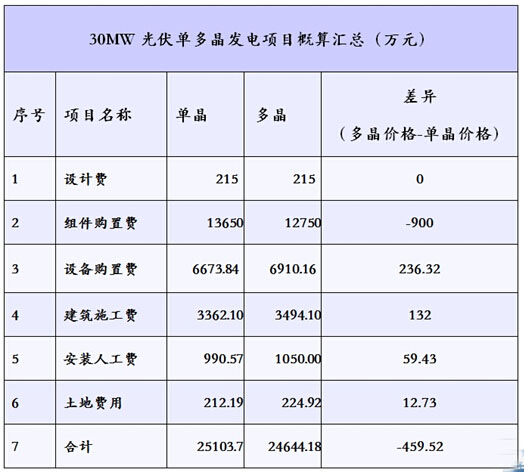
Single crystal 265W module with 4.55 yuan / W, polycrystalline 250W module with 4.25 yuan / W) calculation results show that: polycrystalline initial input lower than the single crystal 0.15 yuan / W;
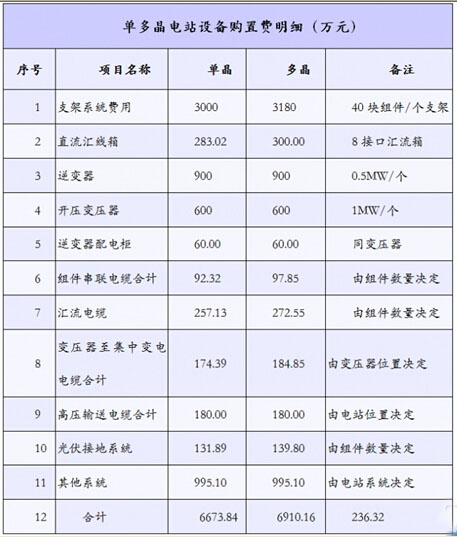
The results show:
1, 265W single crystal and 250W polycrystalline, single crystal module priced at 4.55 yuan / W, polycrystalline module price is about 4.25 yuan / W, according to 30MWp power plant EPC contract unit price of the project to calculate the initial investment in the power station: single The investment of the crystal unit power station is about 8.37 yuan/W, and the investment in the power plant using polycrystalline modules is about 8.22 yuan/W; the difference is 0.15 yuan/W.
2. The monocrystalline power of a monocrystalline module is 5 watts higher than that of a polycrystalline module (1st gear), and the initial investment of more crystals of a single crystal power plant will save about 0.05 yuan/W;
3. In the power station with the same installed capacity, the monocrystalline silicon power station has 5.32% less area than the polysilicon power station;
The difference of income of single polycrystalline station power generation and its reason analysis
As we all know, the profit of a single polycrystalline plant depends on two aspects. First, PV on-grid tariff; second, settlement of electricity. The former depends on the national policy, and the latter depends on the actual power generation of the power station. To this end, we simulated the single polycrystalline power generation in the Zhongwei area of ​​Ningxia.
(1) Single crystal power plant power generation
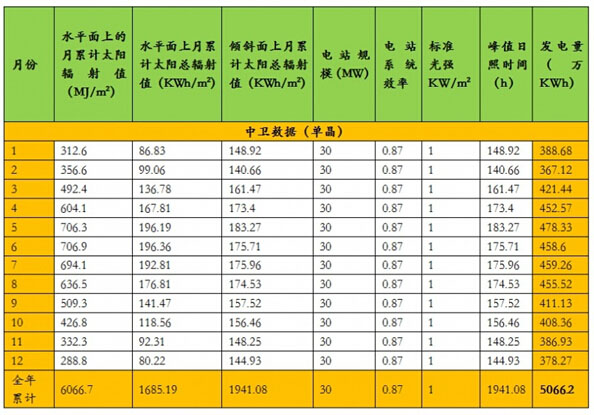
(2) Polycrystalline power plant power generation
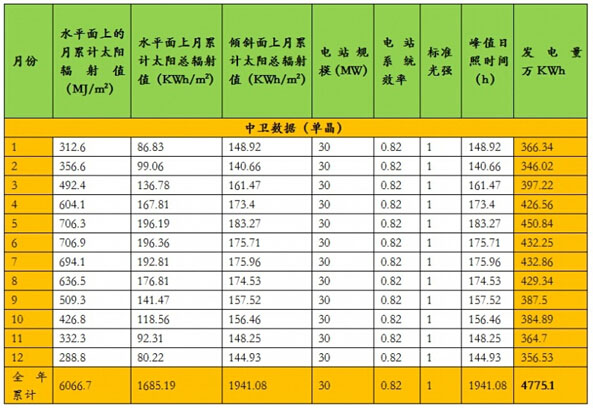
From the above two tables of single-crystal power generation simulation calculation results, it can be seen that the reasons for the difference in power generation between single-crystal and polycrystalline plants are mainly reflected in the efficiency of the power plant system, and mainly include:
1. Loss of power station system;
2, DC side loss;
3, loss on the exchange side:
4, other losses.
Comparison of Efficiency of Single and Polycrystalline Photovoltaic Plants
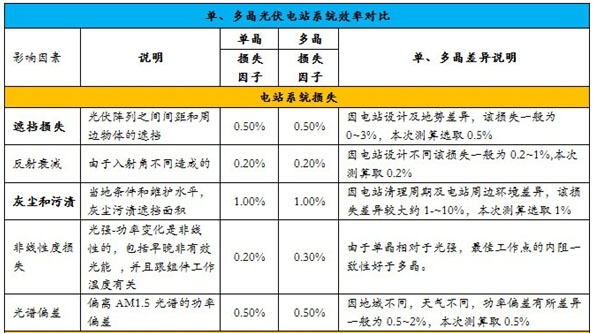

From the photovoltaic power plant system efficiency analysis table, it can be seen that single polycrystals have different directions in their power generation efficiency due to their crystal structure differences:
1, nonlinear loss;
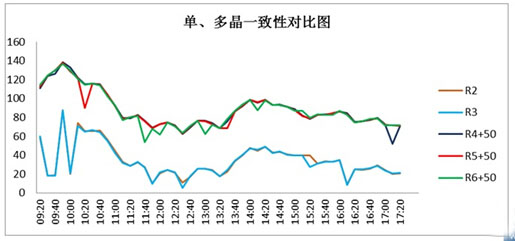
The variation trend of single-crystal power generation and solar radiation values ​​is similar. According to the resistance of the maximum power point of the electronic load, the consistency of the single-crystal assembly is better than that of the polycrystalline assembly, that is, the nonlinear loss is smaller than the polycrystalline.
2. Temperature rise loss of photovoltaic modules;
There are four major sources of photothermal conversion during operation of photovoltaic modules: The first source is a photon with a short wavelength of higher energy. The photon stimulates the photovoltaic cell to generate a portion of the energy remaining after the generation of photogenerated carriers. This part of the remaining energy It is converted into heat energy; the second source is that the photo-generated carriers in the photovoltaic cell cannot be completely collected by the electrode to form the photocurrent, and another part of the photo-generated carriers will be recombined inside and outside the cell. These composite photo-generated carriers Substances also generate heat; the third source is that low-energy long-wave light is not sufficient to stimulate photovoltaic cells to generate photo-generated carriers; this part of photon energy is converted into heat energy; the fourth source is the current in photovoltaic modules. Thermal effect, Joule heating.
The operating temperature of the crystalline silicon photovoltaic module is an important factor influencing the energy conversion efficiency and the power generation of the photovoltaic cell, mainly because the efficiency of the crystalline silicon photovoltaic cell has a negative temperature coefficient, and its photoelectric conversion efficiency decreases linearly with the increase of the battery temperature. When the operating temperature of a photovoltaic cell is increased by 1° C., the power output is reduced by 0.4%-0.5%, and at the same time, the power generation of photovoltaic modules is reduced. Solar energy that has not been converted into electrical energy becomes thermal energy, which accelerates the operating temperature of photovoltaic modules.
In theory, monocrystalline modules have a single crystal structure, high material purity, low internal resistance, and high photoelectric conversion efficiency, and their operating temperature is lower than that of polycrystalline modules. Under the same conditions, single-crystal components with the same nominal power should have higher power generation.
3, the attenuation of the performance of photovoltaic modules;
Crystal silicon battery power attenuation mechanism
1. Initial photo-induced attenuation: This phenomenon is commonly believed in the industry to be produced by the BO complex or the Fe-B complex. Its phenomenon is that the module tends to stabilize when the power generation efficiency drops rapidly to the critical value within the first month. After a long-term monitoring of the initial light fade, the long-term illumination of the cell will slowly rise: the initial light decay is generally slightly larger than the polycrystalline silicon component.
2, long-term aging decay (temperature and humidity environment attenuation): This is due to alternating temperature changes will generate thermal stress within the battery, thermal stress when accumulated to a certain extent, the battery structure will be weak at the break, it will cause the power module attenuation. Or due to aging degradation of the components during long-term use, the crystal structures of single-crystal and multi-crystalline cells are different. Therefore, in theory, single-crystal components will have differences in the thermal stress and temperature and humidity changes.
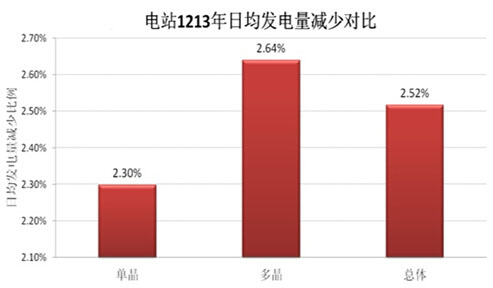
Attenuation of Power Plants: The above picture shows the single-crystal and polycrystalline power generation of the same power station in Zhongwei, Ningxia Province, in 2013 and the reduction of power generation in 2012 as shown in the right figure. Note: Due to possible differences in the actual solar radiation in 2012 and 2013, Therefore, the attenuation absolute value error is large, and it has only reference significance, while the relative value of single crystal polycrystals reflects the actual difference under the same conditions (about 0.34% difference).
4, DC current loss (depending on the difference in the amount of wiring)
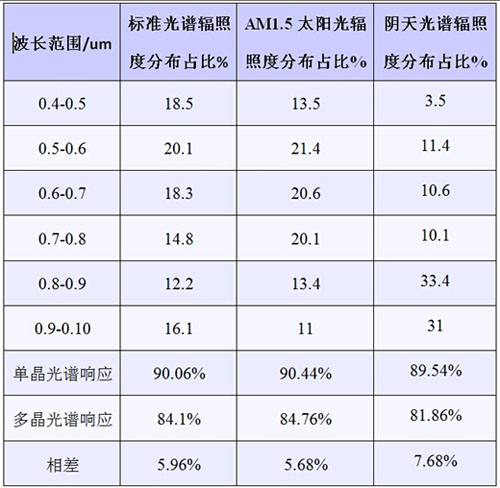
1. The difference of single-crystal PV response under the standard light source is about 5.96%, which is basically the same as the gap under AM1.5 solar irradiation;
2. The diffuse reflection in the air under cloudy, haze and other conditions increases the proportion of visible light and ultraviolet light decreases, and the proportion of infrared light increases. Therefore, we assume that the proportion of infrared irradiance increases by 40%, and the UV and visible light decrease uniformly. At this time, the single-crystal PV response is higher by 7.68%.
3. Assume that the power of the single polycrystalline module is the same, the power output in the AM1.5 sunlight is basically the same in terms of spectral response, and the power of the single crystal is higher than that of the polycrystalline in the weather such as overcast and haze. The analysis results are shown under the assumptions. The single crystal has an additional 2% more spectral response than polycrystals.
According to the above analysis, we can draw a conclusion that the difference in power generation of the 1MWp single polycrystalline photovoltaic power plant in various regions in China is:
· Theoretical gains for each year of a single multicrystalline plant lifetime
First, we assume that the single-crystal power plant's total cost analysis data is as follows:

Single polycrystalline plant revenue and expenditure project summary table

25-year single polycrystalline station income comparison table
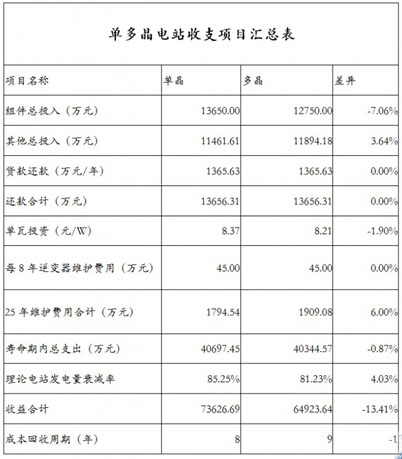
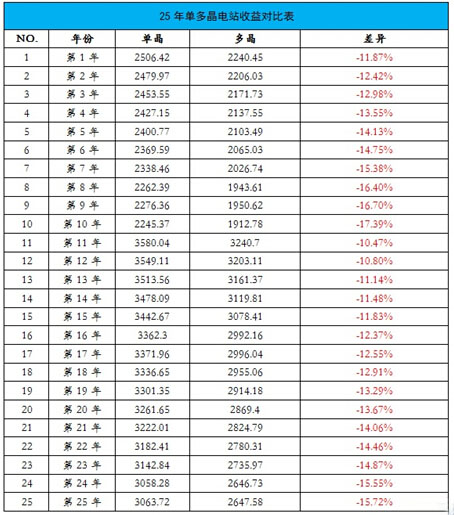
Summary: 1. The initial investment of the power station: single crystal: 8.37 yuan/W, polycrystalline: 8.22 yuan/W. Total investment in the power plant life cycle: single crystal: 13.57 yuan / W, polycrystalline: 13.45 yuan / W.
2. According to the irradiance conditions in the Zhongwei area of ​​Ningxia, the single-crystal polycrystalline power generation in the first year was simulated: single crystal: 1.69 degrees/W, polycrystalline: 1.59 degrees/W. The total power generation during the service life of the power station during the service life is 38.11 degrees/W in single crystal and 35.09 degrees/W in polycrystalline.
3. The total revenue of the power station during the service life: single crystal: 24.54 yuan/W, polycrystalline: 21.64 yuan/W. The yield of single crystals is 13.41% higher than that of polycrystals.
We also verified our theoretical analysis by analyzing the actual power generation of two single-crystal polycrystalline power stations in Ningxia;
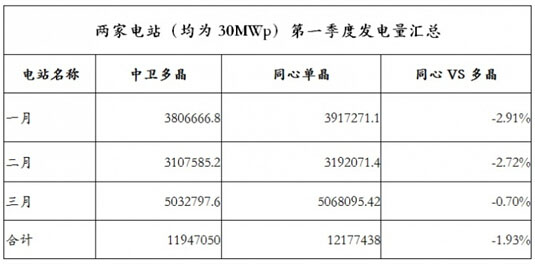
Theoretical calculations show that the difference in single-crystal power generation in Zhongwei area is about -6.2% (polycrystalline is lower than that of single crystal); the actual power generation of the two power plants in the first quarter is poly-differential to concentric difference of -6.52%. It is very similar to the calculation of simulation results.
At present, the industrialization level of polycrystalline batteries is 17%-17.5%; the industrialization level of N-type single-crystal batteries is 21%-24%; the industrialization level of P-type single crystal batteries is 18.7%-19.2% (domestic), 19.2% -20% (overseas). Monocrystalline cells are superior in terms of efficiency.
In Q1 2014, the conversion efficiency of single crystal modules was 16.6%, and the cost was US$0.47/W. The conversion efficiency of single crystal modules in 2017 is expected to be 17.7%, and the cost is US$0.37/W; and the conversion efficiency of Q1 polycrystalline modules in 2014 is 15.7%. US$0.45/W. It is estimated that the conversion efficiency of polycrystalline modules in 2017 will be 16.5% and the cost will be US$0.37/W.
According to Zhong Baoshen, chairman of Xi'an Longji Silicon Materials Co., Ltd., it is predicted that by 2017, single-crystal modules and polycrystalline modules will be equal in cost. "In the case of single-crystal module costs and polycrystalline module costs are the same, the single-crystal installation cost premium will make single crystals per watt system cost will have advantages." At the same time Zhong Baoshen believes that crystal silicon will still be the mainstream of the photovoltaic market, high-efficiency single crystal The product's price/performance advantage will gradually be recognized by the market, and the market share will increase rapidly.
It is reported that the current non-silicon cost of single-crystal silicon wafers is 0.115 US dollars per watt, which will be reduced to 0.1 US dollars per watt next year, and can be reduced to 0.06 US dollars per watt within three years.
Recently, the domestic photovoltaic giant GCL-Poly has stated that it will fully expand the R&D and expansion of single-crystal products, and further validate the potential of single-crystal components in the future. Similarly, the US system integrator Solar City (SCTY) released a blog on the official website on the 17th that it has signed an agreement to acquire Silevo, an American manufacturer of high-efficiency single crystal photovoltaic modules, and plans to build a component plant with an annual production capacity of 1GW or more in New York State within the next two years. The acquisition event once again verified that the high-efficiency single crystal route will be a clear development trend for the future photovoltaic industry.
At present, high-performance battery module manufacturers based on N-type single-crystal silicon wafers are mainly US SunPower and Panasonic Japan (acquired Sanyo), both of which can produce more than 22%/20% conversion efficiency of high-efficiency single-crystal cells/components. However, the disadvantage is that the complex production process determines the high cost level. In recent years, many companies such as Silevo, LG, TetraSun and other companies have made remarkable achievements in research and development and production of low-cost high-efficiency crystalline silicon cells, and they are all based on N type. Monocrystalline wafers.
Following TetraSun's acquisition of FirstSolar last year, Solarcity's acquisition of Silevo again illustrated the recognition of efficient single crystal technology routes by leading international companies in the photovoltaic industry, and also validated the many industry perspectives that we previously highlighted in the report: With global photovoltaic terminals Demand structure to the transfer of small and medium-sized roof, the cost of components in the cost of the composition of the system continues to decline, high-tech single crystal technology line will be a clear development trend of the photovoltaic industry.
In the national plan, distributed photovoltaic power generation is encouraged, and photovoltaic power generation is subsidized by electricity, that is, subsidy based on actual power generation. Changing the practice of subsidizing projects directly in the past has prompted power station developers to pay more attention to the conversion efficiency and economic efficiency of batteries. The advantages of single crystal silicon products have been highlighted.
At present, there are mainly five monocrystalline silicon wafer manufacturers in China, namely Longji, Comtec, Central, Hebei Jinglong, and Sunlight Energy. From last year to this year, we have continuously introduced standardized new single-crystal wafers. We believe that once the scale is in place, the cost of monocrystalline silicon will be more competitive.
At present, Xi'an Longji Silicon Material Co., Ltd. has successively acquired Zhejiang Leye Photovoltaic Technology Co., Ltd., dedicated to the production and sales of single crystal modules, and established Xi'an Longji Clean Energy Co., Ltd., whose main business is large-scale ground power station and distributed PV power plant investment, construction, operation and maintenance. The Ningxia Longji Tongxin 30MWp single crystal photovoltaic power station has been connected to the grid for power generation. The annual output of the 30MWp power station exceeded 50 million kWh, and a second-phase 30MWp single crystal photovoltaic power station is currently under construction. It is believed that domestic PV power plant investors will tend to use monocrystalline components.
With the recent introduction of the distributed photovoltaic policy of the National Energy Administration, especially the "two-election one" model and the expansion of the definition of distributed power stations, China will surely usher in an upsurge in the investment and construction of distributed photovoltaic power plants. It is expected that the third quarter will It began to become active and Zhejiang and Shandong provinces will become frontier battlefields for distributed photovoltaic power plants. In terms of the value of the power station, the cost of electricity is the sole criterion for measuring the price of electricity. For investors, how to reduce the cost of electricity is extremely important. By strictly monitoring the control of power plant equipment, it can be realized. The hard guarantee for the enhancement of the value of the power station, and at the same time the soft guarantee, is also very important. This is mainly reflected in the complete and limited on-site investigation of the owners of the target before the investment in the distributed photovoltaic power station, mainly reflected in the roof area, load, and Electricity, electricity prices, credit information of the owners, industry development scenarios and other factors that the owners are engaged in. The author will carefully analyze the factors of investment due diligence in PV power plants in the next article.
Dynachrome is Mordant Dyes with good levelling, outstanding fastness to light and washing.
Mordant Dyes Must use certain metal salts (such as aluminum, chromium salts, etc.) for the media, in order fixing the dye on the fiber. Such as alizarin must be aluminum (alum) for the media, in order to cotton fibers dyed red. The more complex staining procedure, dye products are generally dark color.
Mordant Dyes
Mordant Dyes, Mordant Black Dyes, Mordant Dyes Blue
Dynasty Chemicals (NingBo) Co., Ltd. , https://www.dychemco.com